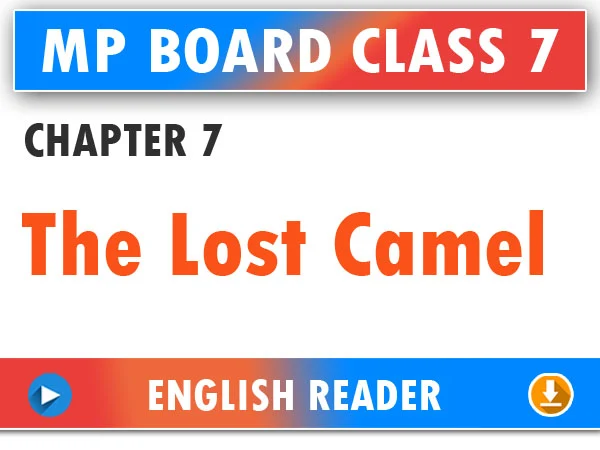Chapter 7 The Lost Camel
MP Board Class 7 English Reader Chapter 7 The Lost Camel
Video
MP Board Class 7 English Reader Chapter 7 The Lost Camel
Question Answers
Exercise
Word — Meaning
Camel (कैमल्)-ऊँट.;
Duck (डक)-बतख;
Elephant (ऐलीफेन्ट)-हाथी;
Lion (लायन)-शेर;
Merchants (मर्चेन्ट्स)-सौदागर;
Searching (सचिंग) -खोज रहे;
Lost (लॉस्ट)-खोया हुआ;
Desert (डेजर्ट) -रेगिस्तान;
Drag (ड्रेग)-खींचना;
Owners (ओनर्स) -मालिकों;
Lame (लेम)-लंगड़ा
Blind (ब्लाइन्ड) -अन्धा;
Surprised (सरप्राइज्ड)-अचम्भित हुए;
Indeed (इन्डीड)-वास्तव में;
Sure (श्योर)-निश्चित;
Honey (हनी)-शहद;
Caught hold of (कॉट होल्ड ऑफ)-पकड़ लिया;
Angrily (एन्ग्रीली)-नाराजगी से;
Calmly (कामली)-चुपचाप;
Listened (लिसन्ड)-सुना;
Footprints (फुटप्रिन्ट्स)-पदचिह्न;
Smiled (स्माइल्ड) -मुस्कुराया;
Animal (एनीमल)-पशु;
Bees (बीज़) -मधुमक्खियाँ।
Read and Learn
Ans (Do Yourself)
Word Power
(A) Match the words with their meanings :
Answer :
(i) (a) Calmly
(ii) (e) Bee
(iii) (b) Merchant
(iv) (c) Lame
(v) (d) Footprint
(B) Fill in the blank spaces using the given words or phrases:
(carrying, understand, searching, the ship of the desert, a lame excuse, foolproof, to work hard, to turn a blind eye, leave footprint, angry)
1. Bhola was ………… for his ball.
2. The truck was ………… bags of onions.
3. The teacher was ………… because Suraj did not do his work.
4. No one could ………… the story told by Ramesh.
5. The police ………… When they saw the thief was running away.
6. The camel is known as …………
7. Ramesh had not done his homework so he made ………… of falling sick.
8. Some products in the market claim to be a ………… remedy for illness.
9. Shyama has ………… to secure good marks.
10. If you ………… on the sand at a beach, the sea is sure to wash them away.
Answer:
1. searching
2. carrying
3. angry
4. understand
5. turned a blind eye
6. the ship of the desert
7. a lame excuse
8. foolproof
9. to work hard
10. leave footprint.
Comprehension
(A) Answer these questions.
(i) Why were the two merchants surprised at the old man’s questions?
Ans- The two merchants were surprised at the old man’s questions as they thought how he could know about their camel that it was lame, blind in the left eye, carrying wheat on one side and honey on the other side of its back.
(ii) Why did the merchants think that the old man had seen the camel?
Answer- The merchants thought that the old man had seen the camel because he gave the real information to the merchants about their camel.
(iii) Why did they take the old man to the Khalifa?
Answer- They took the old man to the Khalifa because they thought that he had stolen the goods and killed the animal.
(iv) How did the old man know that the camel was blind?
Answer- The old man knew that the camel was blind in the left eye because it had eaten the leaves of bushes on only one side of the road.
(v) Why were the bees flying on one side of the road?
Answer- The camel was carrying honey on one side of its back so the bees were attracted to it and were flying on one side of the road.
(vi) Why did the Khalifa not punish the old man?
Answer- The Khalifa did not punish the old man because he had made wise use of his eyes to look at things.
(B) Complete the following sentences using the correct option:
1. The two merchants were looking …………..
(a) for their friend
(b) for their lost camel
(c) for their family members.
Answer:
(b) for their lost camel.
2. The old man’s answers were in the form of …………..
(a) silence
(b) statements
(c) questions.
Answer:
(c) questions.
3. The old man asked whether …………..
(a) The camel could not walk fast
(b) the camel carried a heavy load
(c) the camel was lame.
Answer:
(c) the camel was lame.
4. The merchants were angry because …………..
(a) They thought that the old man had stolen the goods and killed the camel.
(b) They thought that the old man was making fun of them.
(c) They thought that they would never get their camel back.
Answer:
(a) They thought that the old man had stolen the goods and killed the camel.
5. The old man knew the camel was lame because …………..
(a) one of its footprints could hardly be seen.
(b) the ants carried fallen grains from one side of the road.
(c) he had seen the camel before.
Answer:
(a) one of its footprints could hardly be seen.
6. The Khalifa said that the old man knew so much about the camel because …………..
(a) he was an expert
(b) he had killed the camel
(c) he used his eyes to look at things carefully.
Answer:
(c) he used his eyes to look at things carefully.
7. The merchants went to …………….
(a) the camel
(b) the Khalifa
(c) the king.
Answer:
(b) The Khalifa.
8. The camel was …………..
(a) lame in one leg
(b) blind in one eye
(c) both lame in one leg and blind in one eye.
Answer:
(c) both lame in one leg and blind in one eye.
9. The Khalifa said to the merchants …………….
(a) use your ears
(b) use your eyes
(c) use your mouth
Answer:
(b) use your eyes.
10. The old man had…
(a) stolen the camel
(b) killed the camel
(c) never seen the camel.
Answer:
(c) never seen the camel.
Page No. 54
(B) Read the following passage carefully and then answer the questions given below it :
The camel is one of the oldest of the domestic animals. It has been used for thousands of years by the desert people of Africa and Asia to fulfil several of their needs.
On the fertile edges of the desert, camels pull ploughs, turn wheels to irrigate fields and carry goods to the market. In the desert itself, they are still almost the only means of transport. They supply foot, milk and clothing in the form of wool and leather.
This useful animal is well adapted to life in harsh, dry lands. The Arabian camel has one hump which is used as a source of energy when food and water are scarce. When it does drink, the camel can take upto 100 litres of water in ten minutes.
The camel has brad, soft feet for a steady grip in the sand. A thick skin protects it from the hot daytime sun and bitterly cold nights. The camel's eyes have three eyelids to help keep out sand, its ears and nose are also adapted to keep out sand storms.
Camels stand about two metres high at the shoulder and weigh 500-600 kilos. Often called "the ship of the desert" while travelling long distances, they can carry loads of 200 kilos and more.
Camels eat grass, dates and grain when available. Deep in the desert they survive on dry leaves and seeds.
1. In what ways can the camel help us in agriculture?
2. What's the use of the camel's hump?
3. How is the camel's body suited to the desert's hard conditions?
4. What does the camel eat?
5. Give a suitable title in the passage.
Answer :
1. Ans: On the fertile edges of the desert, camels help in agriculture by pulling ploughs and turning wheels to irrigate fields. They also carry goods to the market.
2 Ans: The camel's hump stores energy, which helps the camel survive when food and water are scarce.
3. Ans: The camel has broad, soft feet for walking on sand. It has thick skin to protect it from heat and cold. It also has three eyelids, and special ears and nose to keep out sand during sandstorms.
4. Ans: Camels eat grass, dates, and grain when available. In the desert, they survive on dry leaves and seeds.
5. Ans: The Ship of the Desert
Related Searches
- Chapter 7. The Lost Camel
Related Searches
- Chapter 7. The Lost Camel




